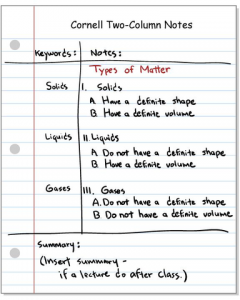
[iStock]
Studies show that when students actively take notes during our lessons, it helps them focus during the lesson. It also breaks down the content taught into manageable parts that allow them to digest and absorb easily.
Good note-taking also improves students’ active listening, comprehension of material and information retention.
This has led to the development of various note-taking strategies to give students a chance to improve their note-taking and make it easier for them to understand the content we teach.
One of them is the two-column note-taking strategy. What is it, and how can we apply it to our lessons? Let us find out more.
What is the Two-Column Note-Taking Strategy?

[Virtual Library]
Also known as the Cornell two-column note-taking strategy, the two-column note-taking strategy is a method of note-taking that involves dividing the page into two columns.
On one side, students write down the main ideas and key points that they take from lectures and lessons, while on the other, students write down the sub-points and details. This technique is often used to help students analyse rich content, allowing them to break the information down.
Of course, there are many variations of this method. Here are the 5 most common variations:
1. Main Idea-Detail Notes
2. Opinion-Proof Notes
3. Hypothesis-Proof Notes
4. Problem-Solution Notes
5. Process Notes
Each variation serves to help students to identify certain points like cause-and-effects, opinions, or themes that help them answer examination questions.
Benefits of Using the Two-Column Note-Taking Strategy

[iStock]
As with other note-taking strategies, there are many benefits to using the two-column note-taking method. After all, this note-taking strategy is used to help students understand the content better, and it also helps them to answer exam questions.
Here’s how it benefits students.
Organise and identify key points and common concepts
One of the main benefits is that it helps students identify key points and common concepts.
Since all the points are written in a clear and easy-to-read format, students don’t need to read long paragraphs of information, making it easier for them to revise for their exams.
Using this note-taking method also organises the key points and common concepts away from explanations, details and examples. This declutters the notes, making it easier for students to refer to during their revision sessions.
Promotes critical thinking
Another benefit for our students to use the two-column note-taking strategy is that it promotes critical thinking.
In variations like the Opinion-Proof Notes or the Problem-Solution Notes, students are encouraged to analyse the evidence and main points and then make their own conclusions or opinions after.
They comprehend and understand the information we teach. Then they take it a step further and use critical thinking to come up with solutions or opinions that can be used to answer exam questions.
Helps students to prepare for exam questions
Initially, students need to determine important points and concepts and write them in the left column, then they elaborate on these points in the right column. But they can also add a third column where they create test questions.
This helps them to comprehend and determine what is important. At the same time, they predict the types of questions that might come up for certain concepts and topics, allowing them to study the answers and concepts. This makes them better prepared for the exam too!
Prepare for their summary writing
When your students get the hang of using this note-taking method, they can start to use it wherever it is applicable. For example, using it for their comprehension summary writing.
Here’s how they can use this method for writing their summaries:
1. They can use the two-column note-taking strategy to jot down the important points that need to be included in the summary.
2. After writing the main points in one column, they can add supporting or essential details in a second column. Then, students write one or two sentence summaries to encapsulate the main ideas.
3. They can use this note-taking method to organise their thoughts and plan their summary before writing it.
Steps to Two-Column Note-Taking

[iStock]
So how can you implement the two-column note-taking strategy in your lessons? Here are the steps:
1. Provide your student with a two-column template
2. Ask them to take down the important concepts and key points in the left column and the sub-points and examples in the right column.
3. Carry on with your lesson
4. For the first few lessons, you might want to point out the important points that your student should write down so they know what needs to be noted down. Do note that you shouldn’t need to do this after the first few sessions if not your student doesn’t learn to identify the key points.
5. After the lesson, go through the points with them, discuss solutions and potential exam questions, and then get them to explain what they understand from the lesson.
6. If you want, you can create a third column for them to write these thoughts and conclusions down.
If you teach group tuition, you might also want to consider letting your students complete their notes in groups. Give them some time to collaborate, discuss their thoughts, and come up with solutions to questions.
Conclusion

[Lightfield Studios]
There are many methods and strategies for note-taking, and this two-column note-taking strategy is one of them.
It is simple to use and has many benefits, helping students with their exams and developing their note-taking skills. I hope this article shows you what it is and how you can apply it to your lessons.
How to Make Effective Notes Matching Your Learning Preference
